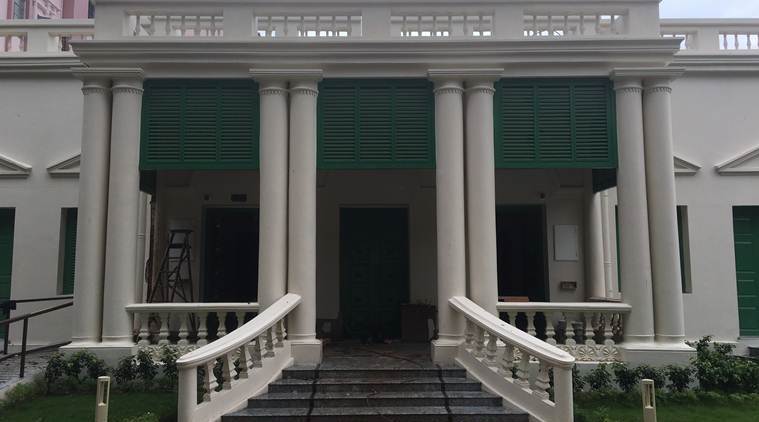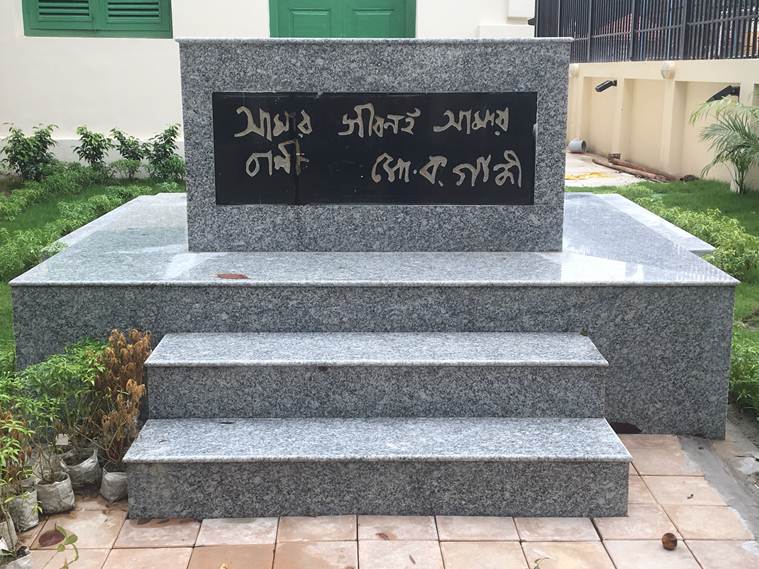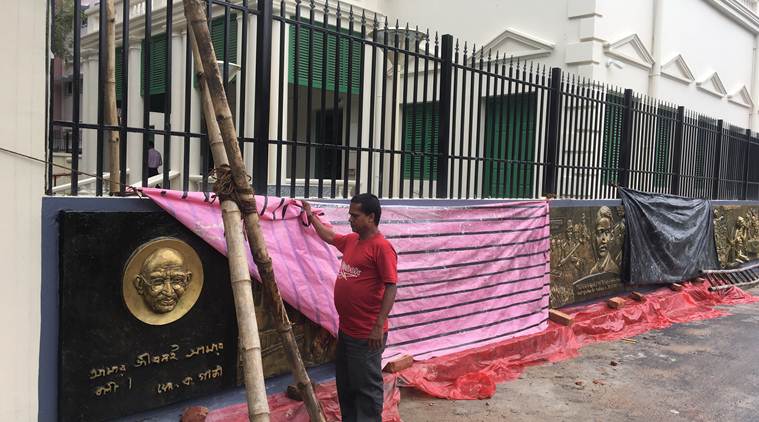In the last week of September, renovations at Hyderi Manzil were feverishly ongoing for the museum to be ready in time for Gandhi’s 150th birth anniversary commemorations on October 2.
Finding Hyderi Manzil in today’s Kolkata is not easy. Few know of its name and even fewer know of its significance. To search for Hyderi Manzil, a relatively small one-storey stucco building painted white in the Beliaghata neighbourhood of the city, one would have to invoke the name of the most well-known of its many residents?—Mohandas Karamchand Gandhi. Hyderi Manzil, christened ‘Gandhi Bhawan’ by West Bengal Chief Minister Mamata Banerjee in 2018, is the last known address where Gandhi lived during his last visit to the city before his death in 1948.
Tucked away in a narrow lane off the main road in Beliaghata, the building has now been made into a museum. In the last week of September, renovations were feverishly ongoing for the museum to be ready in time for Gandhi’s 150th birth anniversary commemorations on October 2.
SEE PHOTOS | The house in Kolkata that hosted Gandhi is now a museum; see pics
Few public records are available for Hyderi Manzil, but its address — 150 Beliaghata Main Road — finds mention in the journal of Nirmal Kumar Bose, a scholar who accompanied Gandhi on his travels across India between 1934 and 1947 and documented daily occurrences in Gandhi’s life. Following the widespread riots and killings on religious lines in Calcutta on August 16, 1946 on what came to be known as as Direct Action Day, Bengal would continue to witness communal strife, especially in Noakhali (now in Bangladesh). According to the journal entries made by Bose in his biography ‘My Days with Gandhi’, national leaders from the Muslim League party and the Congress party made several appeals to Gandhi to bring peace to Bengal, prompting Gandhi to make last-minute changes to his travel schedule to include a stop in Calcutta.
Gandhi reached Calcutta by train on August 9, 1947 with Manu Gandhi and a few others and met with H.S. Suhrawardy who was the Chief Minister of the Bengal Province and Khwaja Nazimuddin, the former Premier of Bengal, “for any instruction which they might wish to give him with regard to East Bengal”. Soon after Gandhi arrived in Calcutta, Bose writes in his journal entries that riots broke out in the city, Syed Mohammed Usman, then mayor of Calcutta, came to Gandhi to request him to help bring calm to Calcutta before departing for Noakhali. At the urging of Usman, Bose writes that “owing to the pressure from many Muslim friends who had seen him, (Gandhi) had decided to stay to see if he could contribute his share in the return of sanity in the premier city of India”. On the night of August 11, 1947, Gandhi put forward two conditions to H.S. Suhrawardy before agreeing to stay back in Calcutta. Bose writes that one condition was that Suhrawardy and Gandhi would have to live together if people wanted Gandhi to stay in the city and help resolve the violence. Hence, Usman along with a few others were set to task to search for a house for Gandhi and Suhrawardy to live in.
Bose’s diary entry for August 12, 1947 says: “Gandhiji wanted Usman Sahib and myself to fix a quarter for him in Calcutta; but I excused myself and Satish Babu’s brother Kshitish Babu and his son Arun Dasgupta accompanied the ex-Mayor on an exploratory tour and finally fixed upon a vacant Muslim residence at 150 Beliaghata Main Road for the new enterprise.” That is how Hyderi Manzil became the building that housed Gandhi on his last visit to Calcutta.
Bose’s entry regarding Hyderi Manzil is a fascinating description of the demographics of Beliaghata in 1947. “Beliaghata is a predominantly Hindu area; but the outlet of this quarter across the canal is commanded by the predominantly Muslim slum of Miabagan,” writes Bose. Although Bose doesn’t mention Hyderi Manzil by name, the name of the building at that address has remained the same over decades. “The building belonged to an aged Muslim lady and lay beside a match factory owned by a Muslim proprietor.”
READ | Gandhi Jayanti: 5 places in Kolkata linked with Mahatma Gandhi you should know about
Partha Ranjan Das, conservation architect at the West Bengal Heritage Commission, who has overseen the restoration of Hyderi Manzil for the past eight months and has delved deep into archives to study the building and its history, told indianexpress.com that the building was initially owned by a Parsi family but he could not find any records for names. “The Parsi family sold it to a Dawoodi Bohra family who were not very rich. The Dawoodi Bohras most probably sold it to a Muslim family who put the buidling on collateral and took loans from United Bank of India,” says Das. At some point in this chain of ownership, Gandhi lived in Hyderi Manzil for 25 days while it still belonged to the Dawoodi Bohra community. “Suhrawardy had wanted to buy it but I don’t think that he eventually bought it. The house had no kitchen and no toilet and maybe it was part of a large complex as an outhouse but I haven’t found any documents,” says Das, explaining that it would have been a difficult place to live in for its inhabitants.
Those were a tense few weeks. The Boundary Commission was scheduled to announce their decision and communal strife in Calcutta was ongoing. Gandhi reached Hyderi Manzil on August 13, 1947 in the afternoon. “A number of young men had gathered at the gate with black flags and some posters which said that Gandhiji should go back and rather settle in a quarter like Kankurgachi or Ultadanga from where Hindus had been driven away, instead of coming here to look after Muslim interests,” writes Bose.
“And thus (Gandhi and Bose) settled down in (their) new quarters in the city of Calcutta.” During his stay at Hyderi Manzil, Gandhi held several prayer meets— prarthana sabhas— during which he heard from local residents of Calcutta. Bose writes that on August 15, 1947, Gandhi undertook a one-day fast “in observance of the day of deliverance of India”, and from Bose’s journal entries, it is implied that the conflict between Hindus and Muslims caused Gandhi distress.
While at Hyderi Manzil, Gandhi witnessed India attaining freedom from British occupation. From Bose’s writings, it appears that the days immediately after independence were busy for Gandhi. The Boundary Commission had made its announcement, hastily fracturing Bengal on religious lines, without much thought to history, demographics, religion, socio-politics etc and chaos and violence in Bengal was consequently amplified. Bose writes that Gandhi stayed in Hyderi Manzil till September 7, 1947, when he took a train to New Delhi.
“He asked me if I was not coming; and when I told him that I had apparently been forgotten and would prefer to salute him not in a crowd but rather alone, he allowed me to touch his feet for blessings,” writes Bose on his last interaction with Gandhi. Bose left the house in Beliaghata and never saw Gandhi again.
According to Papri Sarkar, a member of the Purba Kalikata Gandhi Smarak Samiti, a Kolkata-based organisation that is said to have been started by Jugal Chandra Ghosh, a close associate of Gandhi, for many years Hyderi Manzil was maintained by locals in the Beliaghata area and by members of the Samiti. However, when Gopalkrishna Gandhi became Governor of West Bengal in 2004, he stepped in to oversee the allocation of government funds for maintenance of the building. It was only recently, in 2018, that the state government of West Bengal decided to declare the building a heritage site and initiate work to convert the building to a museum. Today, the Public Works Department of the West Bengal government and the Purba Kalikata Gandhi Smarak Samiti jointly run the operations of the museum and oversee its restoration.
Little is left of the original structure of the building, says Partha Ranjan Das, the conservation architect overseeing the restoration of Hyderi Manzil. Over the years, the Public Works Department had engaged in repairing the dilapidated building of Hyderi Manzil by using pilaster with concrete. “There was no expertise used and the concrete ruined the structure,” says Das of Hyderi Manzil which he estimates is approximately 100 years old. “We tried to use —chuna— to restore it but it would have broken to pieces. This (heritage structure) needed lime mortar which takes a lot of time. But we were forced to use concrete because it had to be ready by October 2. We got the contract for (Hyderi Manzil) in April,” says Das.
Das says that he has tried to restore it to the best of his abilities given the state of the building when he was given the contract. “The house was in poor condition and we had to repair the roof and the floors and the exterior had many cracks.” He says that he went through archives to learn more about the history and was also instrumental in organising the exhibits on Gandhi inside the building. The original layout of the one-storey Hyderi Manzil had one main room that was the hall, with three rooms on the right side of the building and four rooms on left. In one of the two rooms at the back of Hyderi Manzil is where Gandhi stayed while he was fasting. Some of Gandhi’s possessions — his watch, a charkha, his wooden slippers, a lantern, a mattress and his lathi have been made a part of the museum’s exhibit.
Dilip Dey (45), who has been working as a caretaker for Hyderi Manzil for many years now, is excited about the new museum inside the building. “I hope many people, including foreigners will now visit this place,” he says, explaining how many people don’t know of its association with Gandhi. The building of Hyderi Manzil has completely changed as has its surrounding area. A large, open field lies adjacent to the property and a narrow, unpaved lane connects the building to the main road. A sign in red stone that used to read Hyderi Manzil in three languages—Bengali, Urdu and English has been replaced by a huge installation art featuring Gandhi and bust of the leader sits in a patch of grass inside the complex of Hyderi Manzil. Mahatma Gandhi doesn’t live here anymore.
Source: Read Full Article





